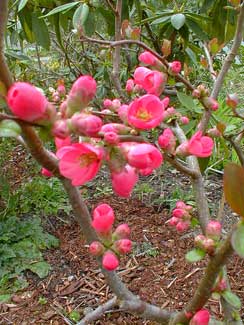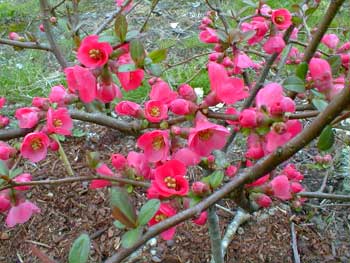
Light Red Hybrid Flowering Quince
"Tart was she as quince,
Living in a fairy land,
Waiting for a Prince."
"Cinderella"
by Robert William Service
(1874-1958)
by Robert William Service
(1874-1958)
Chaenomeles x superba, or the Superba Series of hybrids, are crosses of the Chinese Flowering Quince (C. speciosa) with the Japanese Flowering Quince (C. japonica).
C. speciosa or Chinese Flowering Quince came to Japan in the 1500s & Japanese gardeners began crossbreeding it to their smaller alpine native. The Chinese species reached Europe as an ornamental in 1796, & C. japonica was being gardened in Europe by 1869. Through crosses of variants & select forms & of the two species, more than 500 varieties were developed in a century or so, nearly all of them developed for ornamental purposes, among which the Superba series is most popular.
 Having been developed for the pre-spring & early spring flowers, not all these shrubs fruit well. But there are also a few cultivars developed in northern Europe with fruit production in mind. Generally the market-variety quinces are trees of a different genus altogether, namely Cydonia oblonga. But species of Chaenomeles were formerly categorized as Cydonia, & their tart fruits are also edible.
Having been developed for the pre-spring & early spring flowers, not all these shrubs fruit well. But there are also a few cultivars developed in northern Europe with fruit production in mind. Generally the market-variety quinces are trees of a different genus altogether, namely Cydonia oblonga. But species of Chaenomeles were formerly categorized as Cydonia, & their tart fruits are also edible.The autumn fruits of are famously sour & inedible raw. I prepared myself for something nastier than a lemon & took a bite into one of these fruits only to spit it out very quickly. Yet when cooked & sweetened or mixed with sweeter fruits such as apples, it becomes fragrantly tasty. They're rich in vitamin C, dietary fibre & pectin, thus increasingly valued for juice, pulp & flavoring, & for the cooked fruit's sweet aroma halfway between apple & citrus. Its antioxidant flavinoids are second only to rosehips in concentration.
Flowering quinces are ordinarily quite thorny but thornless varieties are popular among gardeners who are not seeking a vicious protection hedge, or where building codes prohibit such thorny shrubs near street margins. Ours is almost entirely thornless so could go into the sun-garden by the street's sidewalk without threat to passersby.
It has dark-coral late-winter buds which open into gorgeous light-red or mid-red flowers, starting the last week of February & in full glory early in March. Flowers are hermaphroditic, though most shrubs also produce incompete flowers either entirely male or entirely female.
Blooms resemble appleblossoms but pumped up in size & color. They occur on the twisty grey branches before new leaves appear. They are pollinated by bees &and other insects, & if it sets fruit, these will ripen by mid-autumn.
Slow growing, the ten-year height is four to six feet high & a little wider. But it can grow much larger over time. Vase shaped to rounded throughout its young years, eventually it will become a spreading shrub with many horizontal branches reaching outward from the upright limbs.
It is often taken as a truism that flowering quinces are beautiful in flower but have little ornamental value the rest of the year. I disagree with this standard assessment. If a quince is really allowed to take on its mature "reach" it becomes quite a stunning & wild-looking shrub perfect at the sunny edge of a woodland garden or as a specimen shrub for central focus. It is only plain or homely if hedged or pruned without artfulness.
If the direction of twisty branches undergoes training to preserve crooked rusticity, or if it is trained to a large enough espalier so that its bending arms spread out against a wall, it can be gorgeous just for its limb forms & turns. It has to be artfully pruned to reveal its best & most interestingly angled limbs. Because the limbs bend so wonderfully, flowering quinces are popular choices among bonsai practitioners.
But all too often it is just hacked back in a doomed attempt to force it to become something for a small or formal garden, & in that case it is true, it will have poor ornamental value except when flowering. Hacking the shrub back encourages too many interior branchings so that the shrub becomes increasingly a tight & chaotic tangle. But saving & training a few long branches that mature into veritable trunks preserves & encourages rewarding physical shape.
For a garden that cannot give large C. speciosa or largish C. x superba their full reach, a dwarf strain of C. japonica should be chosen instead, so as to avoid trying to hold back a shrub that wants to spread out. The bigger cultivars should at least be permitted to spread a few choice limbs to the fullest possible length, in whichever directions provide sufficient room & which are aesthetically appropriate.
With no pruning at all it will decline in flowering strength, as it blooms on newer wood which is encouraged by post-flower or mid-spring pruning. But when cutting out old wood to height bloom, always leave a set of old limbs with attractive form so that the shrub will not look butchered.
Though mid-spring is the best time to prune, shortly after it stops blooming, it can also be pruned in autumn. But it will have set its buds for the following year's flowers, so such poorly timed pruning will cause it to flower less the following spring.
It wants full sun to flower at its best, but will do pretty well in bright shade too. It is not picky about soil conditions, though excessive alkalinity will cause chlorisis, & organically rich acidic soil keeps it happiest. It can also be rather drought tolerant, though moderate watering in well draining soil will keep it prettier.